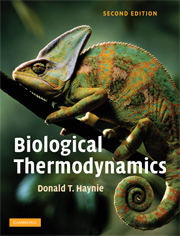Book contents
- Frontmatter
- Contents
- Preface to the second edition
- Chapter 1 Energy transformation
- Chapter 2 The First Law of Thermodynamics
- Chapter 3 The Second Law of Thermodynamics
- Chapter 4 Gibbs free energy – theory
- Chapter 5 Gibbs free energy – applications
- Chapter 6 Statistical thermodynamics
- Chapter 7 Binding equilibria
- Chapter 8 Reaction kinetics
- Chapter 9 The frontier of biological thermodynamics
- Appendices
- Glossary
- Index of names
- Subject index
- References
Chapter 3 - The Second Law of Thermodynamics
Published online by Cambridge University Press: 05 June 2012
- Frontmatter
- Contents
- Preface to the second edition
- Chapter 1 Energy transformation
- Chapter 2 The First Law of Thermodynamics
- Chapter 3 The Second Law of Thermodynamics
- Chapter 4 Gibbs free energy – theory
- Chapter 5 Gibbs free energy – applications
- Chapter 6 Statistical thermodynamics
- Chapter 7 Binding equilibria
- Chapter 8 Reaction kinetics
- Chapter 9 The frontier of biological thermodynamics
- Appendices
- Glossary
- Index of names
- Subject index
- References
Summary
Introduction
We have seen that a given amount of energy can be distributed in many different ways – something like how a certain volume of fluid can adopt many different shapes and adapt itself to its container. In this chapter we turn the spotlight on a thermodynamic function that enables us to measure how “widely” a quantity of energy is distributed.
The First Law of Thermodynamics relates heat, work and internal energy, and it tells us that energy is neither created nor destroyed in all its changes of form; the total energy of a reaction, and indeed of the universe, is constant. The First Law tells us with breathtaking generality that a boundary on the possible is a basic characteristic of our universe. It is not hard to see, though, that the First Law does not tell us some things we would like to know. For instance, if we put a “hot” system into contact with a “cold” one and allow them to come to thermal equilibrium, we find that the final temperature of the two objects, which will persist indefinitely if the combined system is isolated, is at some intermediate value. The value of ΔU for this reaction, however, which obviously proceeds spontaneously, is 0. Similarly, if we add a “concentrated” solution of substance A to a “dilute” solution of substance A, we find that the final concentration of the combined system, which will persist indefinitely if the system is isolated, is between the initial concentrations (Fig. 3.1).
- Type
- Chapter
- Information
- Biological Thermodynamics , pp. 58 - 84Publisher: Cambridge University PressPrint publication year: 2008



